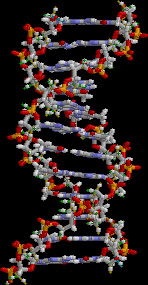
This week we delve into the genes of the mystery organism. Here's a short snippet of DNA:
ATGTCGCGTATCATGGAAAAGGAAAACATCACCGAAAATCTGGAAAAGATTTCCATCAAGAATGCTCGTA
5 points for the first person to pick the genus and species, and 5 points to the first person who can explain why this particular gene was targeted for study.
I'll post the answer tomorrow. Since we've reached the end of the month, I'll tally all the points from the preceding mysteries and announce the March/April mystery winner, who is entitled to either 1) any 8 x 10 print from my photo galleries, or 2) a guest blog slot on any (safe for work) topic.
- Log in to post comments
More like this
Tonight's mystery is a straight-up Name That Bug:
From central Florida, the mystery insect
One point for picking the order, two points for family, five points for genus, and five points for species. [added in edit- you've got to be first in any one category].
And guess what? We've finally decided…
We haven't done an ant mystery for ages. So here you go:
Although I photographed this little ant in Florida, it could just as easily have been in a number of tropical places.
Five points each for the first person to pick the genus and the species.
The cumulative points winner for the month of May…
Tonight's mystery* takes us down into the magical world of scanning electron microscopy.
Five points for picking the organism and five for picking the structure. As usual, only the first correct answer in each category collects the points.
The cumulative points winner for the month of April gets…
Mystery #1
I admit, I like to pick on iStockphoto, the pioneering company behind the high volume/low cost microstock model of media licensing.
There's nothing wrong with microstock. After all, the thriving web-based market for cheap images is a ripe opportunity. But buyers get what they pay for…



Aedes albopictus ribonucleotide reductase, whatever that means
Oh, forgot the R2 part, if that means anything.
Does its targeting for research have anything to do with how UV light can get the gene to produce a different protein?
Asian tiger mosquito. Cool!
Lasius niger
I guess I'll add a little bit more before I go away.
Ribonucleotide reductase changes RNA nucleotides (an A,U,G,C), which have the ribose sugar attached, into DNA nucleotides (A,T,G,C) which have the deoxyribose sugar attached and which are used to build new DNA molecules.
Aedes albopictus is an important disease vector, too, if that helps.
Ribonucleotide reductase (RNR2) is an enzyme involved in the pathway to make DNA nucleotides out of RNA nucleotides. My guess is that this was used, or is being explored for use, in a higher-level phylogenetic study. Housekeeping genes like this one tend to be highly conserved and in low or single copies in a genome, which are two useful qualities for molecular phylogenetics.
The fact that this is A. albopictus and not Aedes aegypti, which has had its genome sequenced, is curious. Also, according to BLAST this is an mRNA, not genomic, which usually points to genes identified in EST studies. The paper that submitted this to GENBANK is from 1999, just pre genomics era, and dealt with the activity of the gene, not phylogenetics, which explains the species used and the mRNA. If this is indeed a new gene you're developing, Alex, I'm interested to hear more.
Looking into it a little more, checking into my database of phylogenetics papers (e.g. google scholar), it appears that mitochondrial RNR2 is fairly commonly used in higher level mammal phylogenetic studies. For instance this one about seals and relatives:
Higdon, J. W. et al. 2007. Phylogeny and divergence of the pinnipeds (Carnivora: Mammalia) assessed using a multigene dataset. BMC Evolutionary Biology 2007, 7:216.
Soooo, mammals. That's probably why I'd never heard of it before. So, if you're using it in insects, I hope it's working well- useful genes are a precious commodity.
According to Pham et al. 2006, the transcription of this gene is upregulated after blood feeding in fat bodies and ovaries of the mosquito. That is pretty cool how feeding on blood feeding is coupled to oocyte development.
Reference:
Pham DQ, Kos PJ, Mayo JJ and JJ Winzeling. Regulation of the ribonucleotide reductase small subunit (R2) in the yellow fever mosquito, Aedes aegypti. 2006. Gene 372: 182-190.
If we choose to follow the controversial revision of Reinert et al. (2004), the species is most correctly called Stegomyia albopicta (Skuse, 1895). However, this classification has not been adopted by geneticians, epidemologists, ecologists or any other typical users of taxonomy; giving it little practical impact. Cf. the much needed nomenclatoral change in Drosophila s.l..
Reinert, J. F., R. E. Harbach, and I. J. Kitching. 2004. Phylogeny and classification of Aedini (Diptera: Culicidae), based on morphological characters of all life stages. Zool. J. Linn. Soc. 142:289â368.